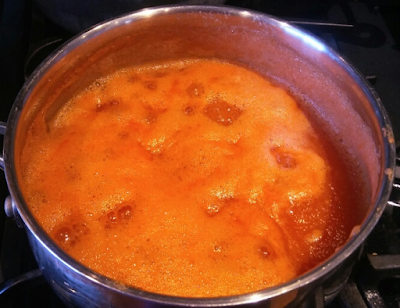 |
| A few more minutes of simmering, and this sauce will be perfect. Actually, if the plan is to simmer it further inside, say, spaghetti sauce, it's ready to go right now. |
Commercially canned tomato products generally contain citric acid made from corn or soy and may contain traces of yeast or mold (see Tomato Products, Canned in the Glossary). If you are so severely allergic to any of these that commercial tomato products are a problem, you might consider making your own. Garden tomatoes picked ripe are the best for this, both because they have the best flavor and because they are not coated with wax containing corn, soy or dairy products and have not been gassed with ethylene gas made from corn. Roma tomatoes have more pulp, which makes them excellent for making tomato sauce or tomato paste.
4 lbs. vine-ripened tomatoes, peeled (see Produce in the Glossary).
4 tsp. fresh squeezed lemon juice (See Juice in the Glossary)
Cut each tomato into a few pieces. Put the tomatoes in a saucepan with a small splash of water. Bring to a boil, reduce heat and simmer, covered, for half an hour. At this point the tomato pieces should be coming apart and the seeds should be softened up so that a blender can break them up. Process the tomatoes, in batches, in a blender. If there are still too many visible seeds to suit you, you can strain them out using a food mill or a sieve with a fine enough mesh. (Remember that any remaining seeds will become more apparent as you reduce the tomatoes.) Put the tomatoes back in the saucepan and, stirring occasionally, simmer uncovered until they reach the tomato sauce consistency you like, probably when their volume is reduced by about half. Add the lemon juice. Do not skip this step if you are planning to can your sauce: one purpose of the lemon juice is to ensure the sauce is acidic enough that you can safely can it at home. Refrigerate or can the sauce.
 |
| Simmered for 1/2 hour, blended, and brought back to a boil. In another hour or two this will look like the sauce shown above. |
Tomato Paste
To turn your tomato sauce into tomato paste, just keep simmering it uncovered until it reaches the tomato paste consistency you like, probably when its volume is reduced by about half again. Note that as it becomes thicker it will require more attention to keep it from sticking and burning. Near the end you will need to keep it at the lowest boil possible and stir frequently. Refrigerate or can the paste.
